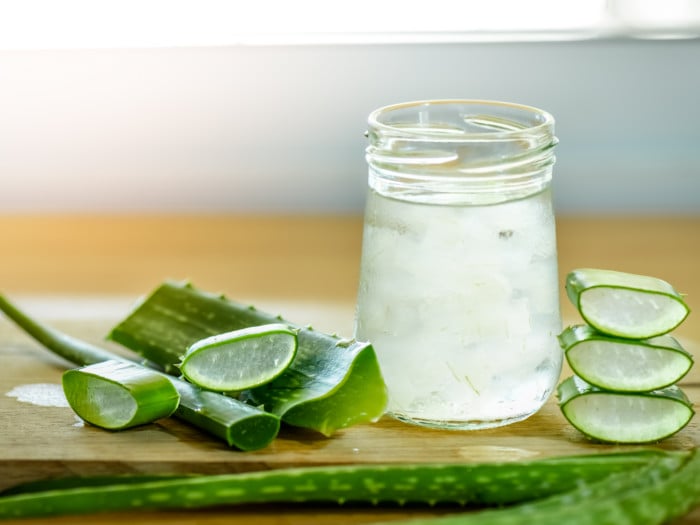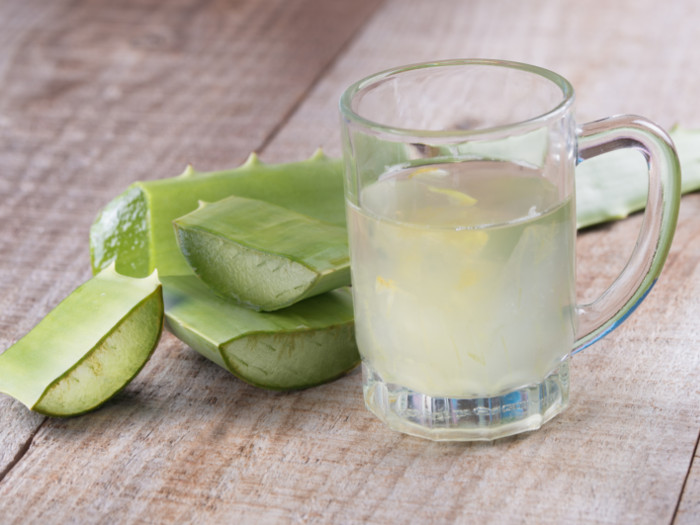Aloe vera juice has been treasured for its hair care properties for a long time. Let’s check out how it helps you and also a short recipe to prepare the juice for your hair care regimen.
Top 6 Benefits of Aloe Vera Juice For Hair
Aloe vera has been touted to have a number of uses, from possibly lowering blood sugar levels to reducing wrinkles, not to forget its possible antibacterial and antioxidant properties. But why should you use aloe vera juice for hair? Here are a few things you should know about how the juice is beneficial for your hair, scalp, and your overall health: [1]
May Enhance Scalp Health
A healthy scalp is a key to your healthy tresses. Owing to several external and internal factors, your scalp could be subject to dryness, dandruff, boils, and several other conditions. Aloe vera used standalone or mixed with other ingredients, might be used to rid the scalp of most of these conditions.
Might Promote Hair Growth
By possibly making the scalp healthier, aloe vera juice can promote the regular growth of healthy hair. This is especially useful if you are facing hair growth issues due to the negative issues of pollution or chemical build-up from hair products, as might break it down, rejuvenate the scalp, and may lead to the growth of healthier hair. [2]

Many people add aloe gel or juice to their morning smoothies for a healthy boost. Photo Credit: Shutterstock
May Prevent Hair Loss
Not only does it lead to the growth of healthier hair, but aloe vera juice may also maintain them and prevent hair loss. It may help condition your locks and seals the moisture in.
May Help Maintain pH Balance
Aloe vera maintains a pH of 4.5. The healthy pH situation for hair and scalp is supposed to be 5.5 while that of the hair shaft is 3.6. Falling between this range, aloe vera is expected to maintain a healthy pH balance. [3]
May Help the Natural Hair Transition
If you are planning to go back to your natural hair, aloe vera juice is your friend. It may break down the deposition of dead skin cells and sebum, which might make way for new skin cells and healthier hair growth.
Natural Product
Aloe vera juice and gel is an all-natural product. Not only is it safe to ingest, but it can also prove to have some benefits. Considering this, it is also very safe for topical application to enhance skin and hair health. While there are packaged options available in the market, you can always make a fresh batch at home.
Might Cleanse and Purify
In a book about Greek herbal remedies around 41-68 A.D., intake of aloe vera was said to have a cleansing effect on the stomach. It may also be helpful for relieving constipation and is thus an option to be considered when going the detox way. Positive consequences of such a detox could include better skin and hair.
Scalp & Skin Protection
Topical application, as well as ingestion of aloe vera juice, is beneficial for the skin, including the scalp. Around the early 1700s, it was discovered to be helpful for treating skin injuries and diseases. Moreover, it can also have a soothing effect, act as an astringent as well as a humidifier. It is said to possibly reduce acne and delay the appearance of wrinkles as well. [4]
How to Use Aloe Vera Juice for Hair?
Aloe vera juice for hair and scalp health can be incorporated into your self-care routine in more ways than one, depending on the needs of your locks. Here are some of the ways you can use this natural product for your hair:
Pre-wash Treatment
Aloe vera juice or gel is a suitable option as a pre-hair wash application. About half an hour before you are supposed to wash your hair, start massaging aloe vera juice into the roots of your hair and lightly along the length. It shall work as a protectant, as well as a treatment routine for dryness and dandruff. You can also wash your hair without a shampoo when using and rinse it with water. [5]
Styling Product
Aloe vera juice can easily be used as a styling gel. It is an impressive option, more so because you can avoid gels full of chemical which could easily damage the chemical structure of your hair and might lead to breakage. It works well with curly or frizzy hair.
Conditioner
Aloe vera juice works well to condition the hair. To use it for this purpose, mix it with some lemon juice. Use it as a regular conditioner on wet hair after shampoo and wash it with water after 4-5 minutes.
Add-on Ingredient
Aloe vera juice is a healthy addition to your regular shampoo and conditioner. Try this when beginning to introduce aloe vera juice to your hair routine, or if you have a sensitive scalp and thin hair. It is also used as an ingredient in some shampoos and conditioners.
Hair Mask
Hair masks are a nourishing option. Prepare one with eggs, apple cider vinegar, hibiscus, yogurt, fenugreek seeds, and ghee, or oils such as castor oil, coconut oil, and more. Depending on the combination of ingredients, they can have various benefits.
Leave-in Spray Conditioner
Refresh your hair on the go with a DIY aloe vera conditioner. Mix this juice with water and coconut oil or olive oil, whichever suits your hair best.
Drink It
Aloe vera juice for hair is not limited to application alone. Drinking this juice has more benefits than healthy hair and skin. Start by having a small amount in the morning and then adapt according to your needs.
How to Make Aloe Vera Juice for Hair?
If you do not have access to any fresh aloe vera leaf or the plant itself, there are many pre-packaged options available online, and even at your local organic store.
However, it is best to use it fresh and thus, to have access to a plant. If you decide to plant one, rest assured that it won’t demand much upkeep.

Ingredients
Instructions
- To prepare a juice, start by cutting a single leaf of the plant at the base.
- Wash it clean with water and skin the flat side.
- Inside, you will find a transparent, white, sticky flesh. Scoop it out into a bowl.
- This will look like sticky gel-like chunks. Blend them by whisking manually or with a blender.
- Store the aloe vera juice in the refrigerator if you intend to use it later, but it is recommended to use it fresh.
Word of Caution: Aloe vera juice is an all-natural product, but you might have allergies or an unpleasant reaction to it. To err on the cautious side, it is best to do a patch test or trial to check for a reaction.
